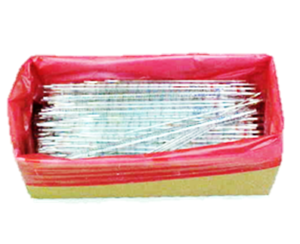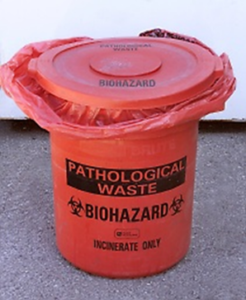Driveway, Outdoor & External Grates & Drains - drain covers
Radiation hazardSign meaning
Biohazardous waste in any form should not be left unsecured in areas that are accessible to the public (i.e., left in hallways). Only lab personnel should remove biohazardous waste from the lab area and transport it to waste holding areas for final disposal.
We're from North Dakota & treat you how we want to be treated. No blaming "policy" for you not being taken care of properly.
In the research lab or field environment, this includes any non-sharp item that is contaminated with human or animal diagnostic specimen material (i.e., body fluids, tissue debris), any microbiological culture material (including recombinant DNA).
NOTE: Diluted bleach solutions may go down the drain in most cases. However, many chemicals used for disinfection cannot be discarded down the train. Contact EH&S at 974-5084 to determine if sink disposal of disinfectants other than diluted bleach solutions is acceptable.
Biohazard sharps receptacle sign meaningaustralia

Disposal for non-sharps and sharps biohazardous waste Basic procedure: Collect biowastes at the laboratory level in designated biohazard-labeled cans per current biowaste collection procedures. Segregate serological pipettes and pipette tips to prevent bag punctures or tears. Collect biohazardous sharps in sharps containers as required (see below). The following are acceptable wastes: stock/propagated cultures of infectious agents; materials that have been used for the collection/processing/storage of human or animal blood or body fluids (including cell lines); recombinant/synthetic nucleic acids; or lab consumables contaminated with any of these materials. The following are unacceptable wastes: hazardous chemicals (e.g. phenol, chloroform, agarose gels with ethidium bromide, etc.); radioactive wastes; bulk liquid wastes (>25 ml/container); pathological waste such as human/animal bulk blood, tissues, or animal carcasses (contact Biosafety for guidance); human fetal remains, limbs, or cadavers; compressed gas cylinders; loose sharps; controlled substances; etc. Once the bag is ~2/3 full, close the bag by gathering the top, twisting, and closing with a single overhand knot. This method of closure minimizes the risk of leaks and spills and is required by DOT (since materials will be transported in commerce). Do not tie the bag closed by crossing tabs (‘bunny or dog-eared’ method). Once the bag is properly closed, double bag it using the same closure technique listed above. The bag can then be deposited directly into a medical waste contractor-provided receptacle, a ~90-gallon bin emblazoned with the company’s name, the universal biohazard symbol, the UN shipping identifier (UN3291) and proper shipping name (Regulated Medical Waste, n.o.s.). Again, autoclaving bags prior to disposal will not be required, except for the following circumstances: Any infectious agent listed on the DOT Category A Infectious Substances list. For UT, this means that stock or propagated cultures of verotoxigenic E. coli, Shigella dysenteriae, and hepatitis B virus are to be autoclaved for a minimum of 30 minutes. Once treated, allow the bags to cool to room temperature, place in a second bag secured according to the above technique and then discard into a medical waste contractor-provided receptacle. Any material under federal permit (e.g. USDA APHIS) requiring onsite inactivation in an approved and validated autoclave. These must be autoclaved according to validated parameters. Once treated, allow the bags to cool to room temperature and then discard into a medical waste contractor-provided receptacle or dispose of in the dumpster. (Note: regulated plants/soils that require onsite inactivation should follow the procedure outlined at https://biosafety.utk.edu/biosafety-program/waste/.) Properly packaged and permanently closed sharps containers may also be discarded into the medical waste contractor receptacles. Sharps containers must be secondarily enclosed in a securely tied (as described above) biohazard bag prior to disposal. Permanently closed sharps containers must be wiped down with a disinfectant prior to removal from the lab for disposal. If there are any liquids present in the biohazardous sharps container, it must be placed in a leak-proof secondary container with a secure lid (and a biohazard label) for transport to the waste collection site or prior to bagging for depositing in the medical waste contractor bins. Disposal of biohazardous sharps containers will be accomplished through a medical waste disposal contractor coordinated through EH&S. Alternatively, sharps containers can be taken to the nearest hazardous chemical waste room (recommended if the sharps containers are very large). The collection of sharps containers in the waste collection rooms will be on the same schedule as chemical waste. Contact EHS for the current chemical waste collection schedule at 865-974-5084. Do not dispose of biohazardous sharps containers in the regular trash, regardless of treatment status. Be sure that all materials being placed into the medical waste contractor receptacles are double bagged prior to depositing packaged waste from the labs (including sharps containers). Lab wastes are not to be placed in the white ‘Autoclave-treated Wastes’ Brute® bins after the medical waste contractor receptacles are placed. Contact Facilities Services for pick up if white bins pictured below remain in your area after red bins have been delivered. Autoclave validation program: Once the Medical waste contractor process is in place, there is no longer a need to do quarterly autoclave validations to satisfy TDEC rules for landfilling treated biohazardous wastes. A subset of volunteers will be asked to continue quarterly validations with biological indicators per USDA permit requirements (as applicable). Autoclaves used to treat Category A Infectious Substances will also be tested at least annually. Otherwise, autoclave testing will be at the discretion of the respective users. EH&S Laboratory Safety Services will continue to supply Class 5 thermal integrator test strips and/or biological indicators upon request. *Note on autoclaved plant and soil waste: While these can technically be deposited into medical waste contractor bins once autoclaved, to reduce bin weight (and disposal cost) it is preferred that these are managed according to the SOP posted at https://biosafety.utk.edu/biosafety-program/waste/. Briefly, collect in clear/white/non-biohazard emblazoned bags, autoclave to tested parameters, allow to cool, and remove to the building dumpster. Do not discard wastes not mentioned here into medical waste contractor containers. If waste is not described here, contact EH&S Laboratory Safety Services for further guidance. On-site Autoclave Treatment (if required above) Autoclavable waste bags must be used in biohazardous waste collection containers. Bags must be placed in a secondary container (i.e., a tray with raised sides), which is placed on a cart for movement to the autoclave facilities. Practice notes on biohazard bags: Biohazard bags are a one-way means of disposal. Do not “dump” the contents from one biohazard bag into another as this action spreads contamination and increases your exposure to this waste. Biohazard bags need to be contained at all times during the collection, treatment, and disposal process. Some lab items may puncture bags and this can lead to leaks and spills. Bags awaiting autoclave treatment should be stored in trays, tubs, buckets, etc. (The only exception to this practice is when small quantities of biohazardous wastes that do not contain liquids are collected temporarily in benchtop containers.) Biohazard bags must not be used for the collection of other hazardous wastes (i.e., ethidium bromide gels). Biohazardous waste bags awaiting treatment should always be stored in pans or secondary containment to prevent spills! Ethidium bromide waste is to be collected in a leak-proof container with a lid lined with a sturdy, non-descript bag. The UT Hazardous Waste label should be placed on the storage container as well. No biohazard labels! Autoclave treatment of this waste must be performed in accordance with the biohazardous waste treatment parameters established for the autoclave. Note: Only personnel who have received training regarding the operation of the autoclave should use this device. Report Health and Safety Concerns or Near Misses (Click symbol below) Training & Events Other UT Safety ResourcesPublic Safety Environmental Health & Safety Institute of Agriculture Safety Radiation Safety Quick LinksQuarterly Autoclave Validation Instructions Waste Pickup Request Form Biosafety Listserv To join the Biosafety Listserv, please contact us at 865-974-5084 or e-mail utbiosafety@utk.edu* (This Listserv is for UT internal use only). Biosafety Program Environmental Health & Safety 5723 Middlebrook Pike, Suite 119 Knoxville, TN 37921 Brian Ranger, MS, SM (NRCM), CBSP - Biological Safety OfficerMain Phone: 865-974-5084 • Fax: 865-974-0094 Email: utbiosafety@utk.edu The University of Tennessee, Knoxville The University of Tennessee, KnoxvilleKnoxville, Tennessee 37996 865-974-1000 Search for: Events A-Z Apply Privacy Map Directory Give to UT Accessibility The flagship campus of the University of Tennessee System and partner in the Tennessee Transfer Pathway.
To join the Biosafety Listserv, please contact us at 865-974-5084 or e-mail utbiosafety@utk.edu* (This Listserv is for UT internal use only).
Poisonsign meaning
Soil and plant wastes do not qualify as ‘regulated medical waste’ per state code, so these are not subject to special segregation into the medical waste contractor receptacles. However, to meet this exemption these wastes cannot be collected in an autoclave bag that is red (or orange) or bears the biohazard symbol (i.e., it must be a plain white/clear/tan autoclave bag). The bags can then be placed directly into the dumpster once autoclaved/cooled. Dry cycles can be incorporated into soil sterilization to possibly help reduce the weight of autoclaved soil. It is important to follow this guidance for autoclaved soils and plant materials as they contribute 11x more to the cost of disposal than other materials in the waste stream. This guidance also applies to USDA permitted soils and plant materials as long as they are fully devitalized prior to final disposition.
We ship without signature required. The carrier may require/add this in some locations. You may also request it in the order notes.
Once the Medical waste contractor process is in place, there is no longer a need to do quarterly autoclave validations to satisfy TDEC rules for landfilling treated biohazardous wastes. A subset of volunteers will be asked to continue quarterly validations with biological indicators per USDA permit requirements (as applicable). Autoclaves used to treat Category A Infectious Substances will also be tested at least annually. Otherwise, autoclave testing will be at the discretion of the respective users. EH&S Laboratory Safety Services will continue to supply Class 5 thermal integrator test strips and/or biological indicators upon request.
Non-sharps solid biohazardous waste must be collected for final treatment and disposal in a leak-proof container lined with an autoclavable bag of moderate thickness to prevent punctures. The collection container must have a lid or other means of closure and the container must be labeled with the biohazard symbol regardless of the lab’s operating biosafety level. For BSL-2 labs, bags must be red, orange, or embossed with the biohazard symbol.
These liquids must be stored in closed, leakproof containers while awaiting treatment and disposal. Collection vessels should be secured so that they cannot be tipped over. Secondary containment is strongly recommended and can be achieved by placing the vessel in a bucket or deep tray. Storage vessels or the secondary container must be labeled with the biohazard label if the liquids will not be treated and disposed of within the shift. If a disinfectant is added to the vessel, provide labeling so that the chemical hazard is identified as well. For instance, if your collection flask contains waste cell media and bleach, place a biohazard label on the flask (or secondary container) as well as the words “bleach-treated cell culture materials” to properly identify both the chemical and biological hazard.
PPEsign meaning
Biohazard sharps Receptacle signlocation
Putco Luminix led flush mount lights is fairly straight forward to install with Putco step by step instructions and included hardware. However, 12 volt light wiring experience is helpful.
Putco® exclusively warrants this premium product to be free of defects in workmanship or materials when properly installed on the vehicle for three years from the original date of purchase. The product must be purchased from Putco.com or through an Authorized Putco® Reseller. Any modification to the wiring unless otherwise specified in the instructions may void your warranty. Subject to some terms, exclusions and limitations, please review our Warranty Policy for additional details.
Tubes of blood and other “breakable” biohazardous waste can be troublesome to manage properly and safely for treatment and disposal. For small amounts of “breakable” biohazardous waste, these items may be placed in sharps containers for disposal. However, if your lab generates a large amount of “breakable” biohazardous waste, please contact the UTK/UTIA Biosafety Officer for assistance with finding solutions for safer waste management.
The housing is made of billet aluminum that is finished off with an anodized matte black with an anodized finish you won’t have to worry about UV rays damaging your flush mount lights for years. This LED light bar can handle the bumps, jars, and pounding your truck gets on and off-road and still work under extreme conditions. The Luminix led flush mount lights push 6000k color temperature for the absolute best offroad lighting experience and have 50,000hours of LED bulb life. They have been vibration tested, dust, immersion, high spray water, salt, and fog for superior performance. Manufactured by Putco of Des Moines, IA.
Autoclavable waste bags must be used in biohazardous waste collection containers. Bags must be placed in a secondary container (i.e., a tray with raised sides), which is placed on a cart for movement to the autoclave facilities.
Biohazard sign meaning
This includes bulk quantities of blood, blood products, body fluids from human and animal research origin and culture media. Note: Disposable primary containers or sample containers containing small quantities of liquids (less than 10 mls) should be managed as solid biohazardous waste.
We pay the return shipping & there are no restock fees if you need to return all or pay of your order for 60 days. See details.
Waste should be collected and stored as previously outlined. Contact the UTK/UTIA Biosafety Officer or UTIA Safety Officer for assistance with identifying disposal options. If you plan to transport waste for treatment and/or disposal, please refer to guidelines at the end of this document for this activity.

NoSharps sign meaning
The collection of autoclaved soil, plants, and plant materials must be conducted in a manner that follows the correct waste stream and does not create ergonomic risks for facilities personnel. This guidance applies to the collection, treatment, and disposal of all soil and plant material as defined below. This shall apply to all students, staff, and faculty responsible for handling and disposing of soil, plants, and plant materials.
Autoclave treatment of this waste must be performed in accordance with the biohazardous waste treatment parameters established for the autoclave. Note: Only personnel who have received training regarding the operation of the autoclave should use this device.
While these can technically be deposited into medical waste contractor bins once autoclaved, to reduce bin weight (and disposal cost) it is preferred that these are managed according to the SOP posted at https://biosafety.utk.edu/biosafety-program/waste/. Briefly, collect in clear/white/non-biohazard emblazoned bags, autoclave to tested parameters, allow to cool, and remove to the building dumpster.
Putco Luminix flush mount LED lights are designed & engineered for 15-degree focus lenses with output from 1200LM to 27,600LM for off-road use. Built to withstand all elements on your adventures and creates a super bright LED beam pattern to light the way. These flush mount led lights are perfect for trucks, SUVs, Jeeps, side by sides, trailers, and much more. made right here in the USA.
Do not discard wastes not mentioned here into medical waste contractor containers. If waste is not described here, contact EH&S Laboratory Safety Services for further guidance.
Biohazardous sharps waste must be disposed of in an FDA-approved container that is manufactured for the disposal of biohazardous sharps waste: 1) puncture resistant; 2) restricted opening disallowing retrieval of sharps; 3) a lid that can be securely closed once full; 4) labeled with the universal biohazard symbol.
Benchtop containers should be used for the collection of small quantities of contaminated dry goods (i.e., pipette tips, centrifuge tubes, etc.). Small plastic containers or wire bag racks lined with a biohazard bag are suitable for benchtop collection. These containers do not need to have a lid (unless waste is contaminated with a pathogen) but daily disposal of the secured bag into a larger collection container such as the one shown to the right is strongly recommended.
Biohazard sharps receptacle signname
Pipette wastes may require creative approaches for accumulation prior to disposal. Serological pipettes and micropipette tips are good examples, as they may not fit some biohazardous waste bins or may present a sharps hazard if they comingle with heavier wastes (e.g., agar plates).
5723 Middlebrook Pike, Suite 119 Knoxville, TN 37921 Brian Ranger, MS, SM (NRCM), CBSP - Biological Safety OfficerMain Phone: 865-974-5084 • Fax: 865-974-0094 Email: utbiosafety@utk.edu
There are 4 general categories of biohazardous wastes based on the physical form of the waste. Each form must be segregated, identified, decontaminated and disposed of in an appropriate manner for the form in order to minimize occupational exposure and environmental release risks.










 13322766566
13322766566